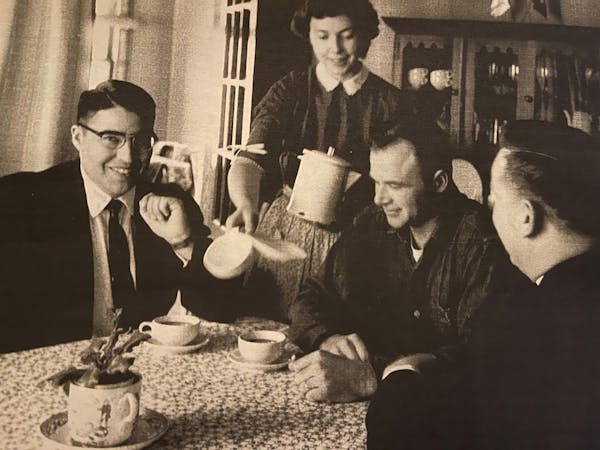Albert Harold Quie never shied from his faith as he lived a life of high-profile public service. Minnesota's sendoff to its former governor celebrated both.
The Republican one-term governor and congressman from southern Minnesota died on Aug. 18, exactly one month shy of his 100th birthday. He was honored over two days, culminating Saturday with a funeral at Central Lutheran Church in Minneapolis, and a rare lying in state at the Minnesota Capitol a day earlier — the first time in nearly two decades a governor's casket was displayed in the rotunda.
"The public doesn't need their public officials to give a sermon, but they expect you to live one," Gov. Tim Walz said at the Capitol on Friday. "Al Quie lived that sermon, lifting up those least amongst us."
Hundreds of current and former politicians, leaders and others who lined the pews at Central Lutheran Church remembered a man known for his humility, love of horses, firm handshake and unwavering Christian faith that guided him through a lifetime of leading with compassion.
Quie's saddle, cowboy boots and hat were displayed at the front of the church alongside a folded American flag to recognize his time serving in the U.S. Navy during World War II. Horses patrolled and munched on the grass outside of the church, prompting the pastor to ask for volunteers to help shovel after the ceremony.
"There's always been a shadow sixth sibling, and that is whatever horse my dad currently owned," Joel Quie said Saturday, one of five children he raised with his wife Gretchen. Joel led the congregation in signing "Happy Birthday" to his father, who had hoped to make it to 100.
A third-generation dairy farmer, Quie ascended quickly from small-town politics to Washington, D.C., representing Minnesota's First District in Congress for two decades. While there, he expanded the presence of the Congressional Prayer Caucus and supported the Voting Rights Act of 1965. He earned the nickname "Mr. Education" for his work advocating for smaller class sizes, long before that issue took hold in the mainstream.
"Over time, as with so many of the things Gov. Quie led on, his view became the prevailing view," U.S. Sen. Amy Klobuchar said.
In 1978, Quie toppled incumbent DFL Gov. Rudy Perpich. But he battled with repeated budget shortfalls during his first and only term in office, and he opted not to seek re-election in 1982.
"Much has been written about his agenda and the successes he had in the Legislature — he would have had more if not for a very severe recession," remembered Roger Moe, Quie's political nemesis in the state Senate who would become a close friend.
After he left office, Quie continued to advocate for schools. He became a regular at the Minnesota Correctional Facility-Lino Lakes, counseling inmates and championing second chances in life. He returned to the Capitol decades after serving as governor to attend a meeting of the board of pardons, where he was supporting a friend seeking clemency.
"His protégé would not have received unanimous approval of all three members if not for Governor Quie, so passionate and eloquent on his behalf," wrote former Gov. Mark Dayton in a letter read by his son Andrew at the lying in state. "That deep humanity was one of his hallmarks."
A lifelong Republican, Quie sometimes bucked his own party and made friends across the aisle. Former GOP Gov. Tim Pawlenty, former Sen. Rudy Boschwitz and state Party Chair David Hann attended Quie's service on Saturday, as well as DFL U.S. Sen. Tina Smith, First Lady Gwen Walz and legislators from both parties.
Other mourners remembered Quie as a kind neighbor, an exemplary boss and a towering figure who liked to take his meetings over breakfast at Perkins. After he left the governor's office, Quie trekked on horseback from Canada to Mexico along the Continental Divide over a span of several summers. He journaled his experience and later wrote a book about it called "Riding the Divide."
"He was a man of the mountains and a mountain of a man," said Lynn Street, who met Quie through their mutual love of horses and was part of a group that joined him on the journey.
"We talked about everything, except for politics," said Street, who attended the funeral and lying in state.
Family and faith always took precedence with Quie, but it wasn't to "get in doors," said Ann Herzog Drewiske, who lived in the same neighborhood as Quie for two decades. "It was truly who he was, it was his essence."
Steve Cwodzinski, a DFL state senator who taught government to some of Quie's 14 grandchildren, said the former governor once offered to lead a tour of the Capitol for his students. Quie paused at his own portrait, pointing out a white church steeple on the bottom corner of one side of the painting, and a smaller Capitol dome on the other.
One of the students asked why the church was bigger than the state.
"He just nodded and smiled," Cwodzinksi recalled. "He didn't answer because he didn't need to."
Arizona judge rejects GOP wording for voters' abortion ballot initiative pamphlet
FBI says Trump was indeed struck by bullet during assassination attempt

